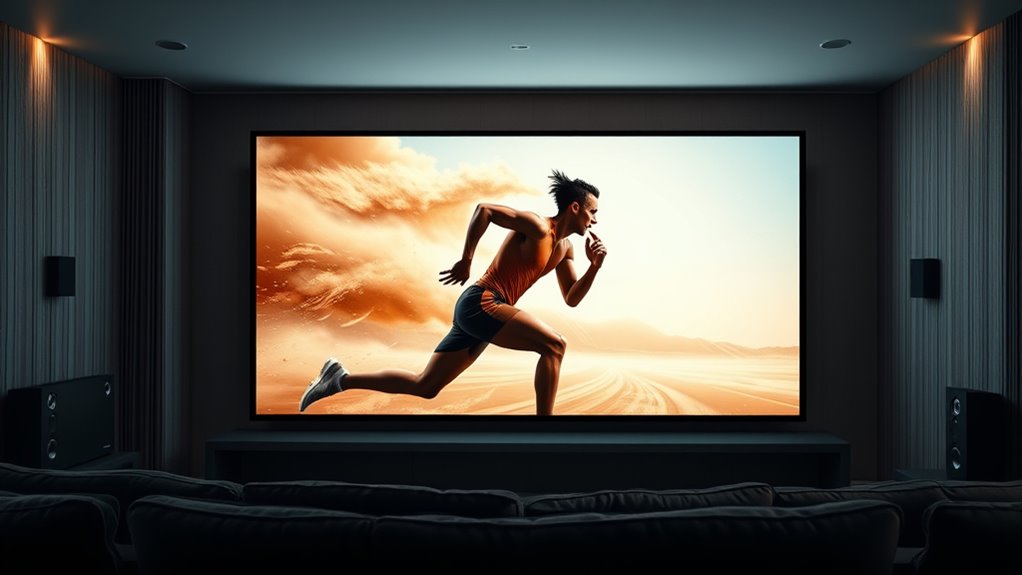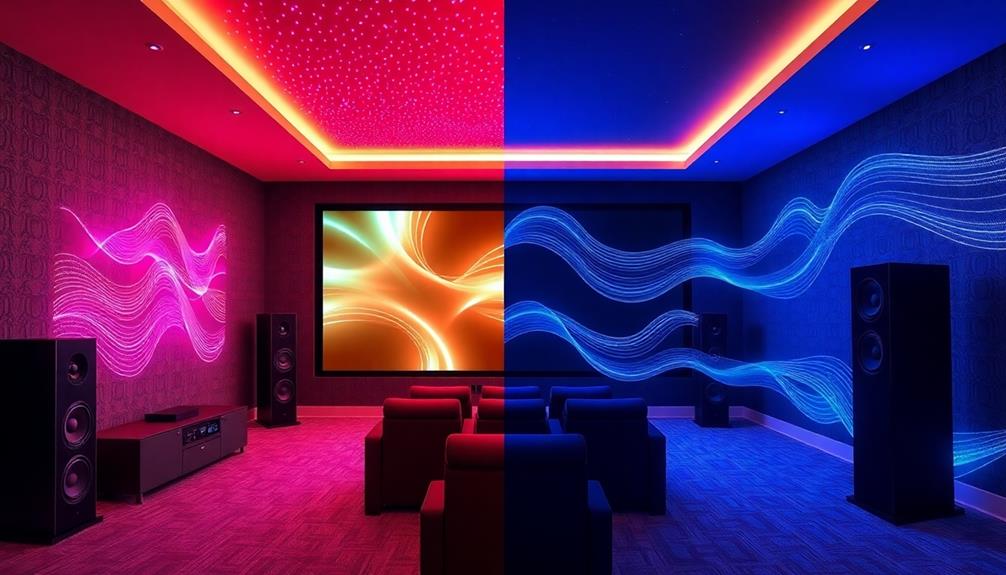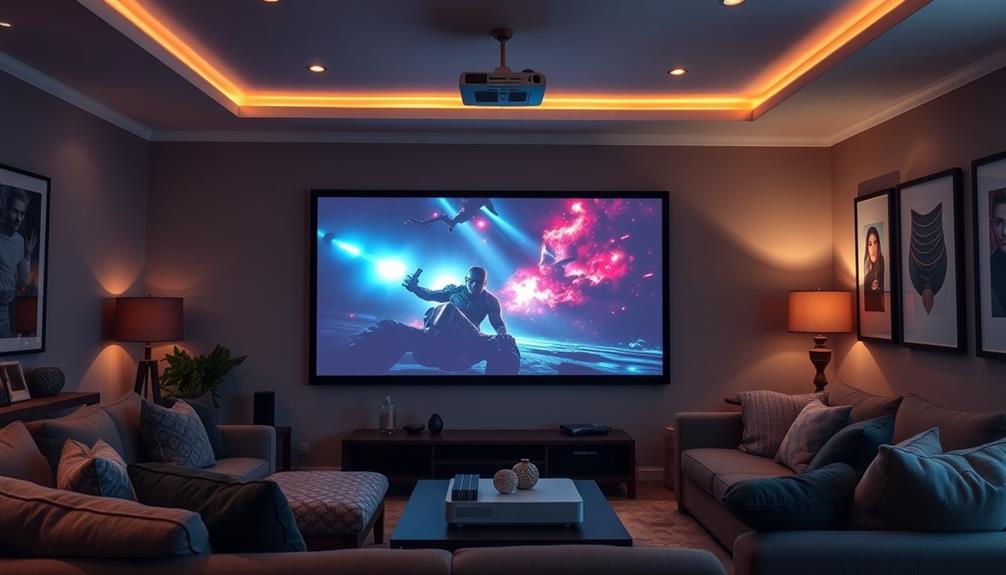High frame rate movies, exceeding 60fps, make fast scenes look smoother and more detailed, giving you a more lifelike experience at home. You’ll notice action, sports, and rapid motion are clearer and more fluid, reducing blur and judder. While some viewers find the ultra-smooth look less cinematic, many enjoy the sharper images. To fully appreciate these benefits, you’ll need compatible hardware, and exploring further will show you how to optimize your setup.
Key Takeaways
- 60fps+ provides smoother, more fluid motion, especially in fast-paced scenes like sports or action movies.
- Higher frame rates reduce motion blur and judder, enhancing clarity and realism during rapid movements.
- Ultra-smooth footage may appear hyper-realistic or less “cinematic,” affecting the traditional film aesthetic.
- Watching high frame rate content requires compatible 4K/8K displays with higher refresh rates.
- Increased availability of 60fps+ content and display tech improves immersive and lifelike home viewing experiences.

Have you ever wondered why some movies look incredibly smooth and lifelike? It’s often because they’re shot and displayed at higher frame rates, typically exceeding 60 frames per second (fps). Traditional movies usually run at around 24 fps, which gives them a certain cinematic quality but can also produce a slightly dreamy or less detailed appearance. When filmmakers start using higher frame rates—like 60 fps or even 120 fps—the images become noticeably clearer and more realistic. This enhanced clarity can make you feel as if you’re right there in the scene, with every detail crisp and motion smooth beyond what you’re used to from standard movies.
Higher frame rates make movies look sharper and more realistic, enhancing clarity and smoothness beyond standard 24 fps.
When you watch a high frame rate movie, you’ll notice that fast-moving action appears incredibly fluid. No more motion blur or juddering images when characters run or objects zip past the camera. Instead, everything looks sharp and smooth, almost like watching a high-quality live broadcast or a video game in real time. This effect can be especially striking during sports broadcasts or action scenes, where the increased frame rate helps you see every detail without distraction. For home viewing, this means your favorite films or live events can feel more immersive and lifelike, elevating your overall experience.
However, the shift to higher frame rates isn’t without controversy. Some viewers find that the ultra-smooth look can make movies feel less “cinematic,” more like a video or television show. This is because the traditional 24 fps has a certain aesthetic that many associate with the art of filmmaking. When you see movies shot at 60 fps or higher, you might feel that the image appears overly sharp or hyper-realistic, stripping away some of the artistic softness and cinematic charm. It’s a subjective experience—some people love the clarity, while others prefer the classic film look.
From a practical perspective, watching high frame rate content requires compatible hardware, including 4K or 8K TVs that support higher refresh rates, along with media sources that can deliver this footage. If you have the right setup, though, you’ll notice that the difference is striking. Fast motion no longer appears blurry or smeared, and scenes look more detailed even at a distance or when you’re watching from across the room. This can make your home viewing sessions more engaging, especially for action-packed movies or sports, where every movement counts. Additionally, refresh rate technology continues to improve, making high frame rate viewing more accessible and seamless.
Moreover, ongoing advancements in display technology are reducing the cost and increasing the availability of high frame rate content, encouraging more viewers to experience these benefits firsthand.
Frequently Asked Questions
How Does High Frame Rate Affect Movie Editing Techniques?
You’ll find that high frame rate movies markedly impact editing techniques. With more frames per second, you need precise timing and smoother shifts, making edits appear more seamless. Fast-paced scenes require careful shot selection to avoid motion blur or jitter. You might also use different effects, like slow motion, more effectively. Overall, working with higher frame rates pushes you to focus on clarity, fluidity, and maintaining visual consistency throughout the editing process.
Are All Streaming Platforms Capable of Supporting 60fps+ Content?
Not all streaming platforms support 60fps+ content. You might find that services like Netflix or YouTube can manage higher frame rates, but others may lag behind due to bandwidth or technology limitations. To enjoy smooth, high-frame-rate videos, you need a compatible device and a fast internet connection. Check your platform’s specifications and verify your hardware is up to date to get the best viewing experience.
What Equipment Is Needed to Watch High Frame Rate Movies at Home?
Imagine stepping into a world where every detail feels alive, like peering through a window into reality. To watch high frame rate movies at home, you need a 4K UHD TV or monitor that supports 60fps or higher, a compatible media device or streaming service, and a reliable internet connection. HDMI cables that handle high bandwidth also help guarantee smooth playback, turning your living room into a front-row experience.
Will Higher Frame Rates Improve the Viewing Experience for All Genres?
Higher frame rates can enhance your viewing experience, especially in action-packed or fast-moving scenes, by providing smoother motion and clearer details. However, not every genre benefits equally; dramas and character-driven stories might feel less immersive with high frame rates. Ultimately, whether you’ll enjoy the improvement depends on your preferences and the type of content you watch. If you love clarity and smoothness, higher frame rates could be worth trying.
How Does High Frame Rate Impact the Overall Film Production Cost?
Imagine you’re in 1999, watching a movie on dial-up internet—high frame rates do impact production costs. You see, shooting at 60fps or higher requires more specialized equipment, additional lighting, and longer post-production times. These factors increase expenses for filmmakers. So, just like upgrading from a flip phone to a smartphone, adopting high frame rates demands more investment, which can influence overall film budgets and possibly ticket prices.
Conclusion
Think of high frame rate movies as stepping into a crystal-clear window, revealing every detail with astonishing clarity. Just like upgrading from a dusty lens to a pristine one transforms your view, 60fps+ brings movies to life with vibrant realism. It’s like trading a blurry sketch for a vivid, immersive painting. Embrace this shift, and your home viewing becomes a gateway to worlds so real, they feel like you’re right there, experiencing every heartbeat in perfect detail.















